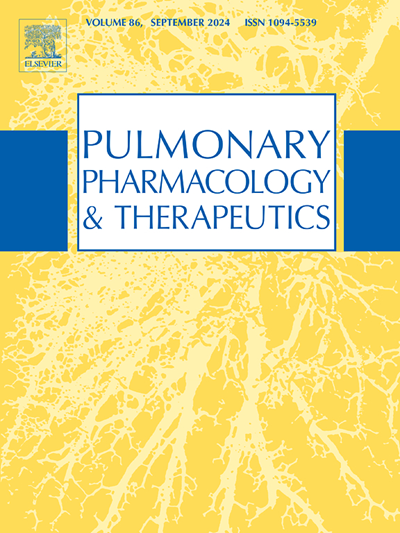Pharmacovigilance of five commonly used antibiotics in acute exacerbations of COPD (AECOPD): Analysis of the FDA adverse event reporting system database
IF 2.8
3区 医学
Q2 PHARMACOLOGY & PHARMACY
引用次数: 0
Abstract
Objective
Antibiotics are commonly administered during acute exacerbations of chronic obstructive pulmonary disease (AECOPD) to manage infections and alleviate their symptoms. However, their use may result in adverse drug events (ADEs), potentially compromising patient safety and treatment effectiveness. The U.S. Food and Drug Administration Adverse Event Reporting System (FAERS) provides valuable data for identifying such risks. This study aimed to analyze FAERS data to detect ADE signals associated with antibiotic use in patients with AECOPD, thereby supporting safer clinical practices.
Methods
Five antibiotics frequently used in AECOPD management, azithromycin, moxifloxacin, meropenem, gentamicin, and minocycline, were selected for analysis. FAERS data from January 1, 2004, to July 30, 2024, were extracted using OpenVigil 2.1 platform. Duplicate and incomplete reports were excluded. ADEs were coded using the Medical Dictionary for Regulatory Activities (MedDRA). Data mining techniques, including the proportional reporting ratio (PRR) and reporting odds ratio (ROR), were used to identify statistically significant ADE signals.
Results
111,179 ADE reports involving 100,602 patients were identified, including azithromycin (41,241 reports), moxifloxacin (46,770), meropenem (5,904), gentamicin (4,142), and minocycline (13,122). Serious events comprised 30.6 %–47.1 % of the reported ADEs, with the lowest proportion observed for meropenem, and the highest proportion observed for gentamicin. Females accounted for 57.0 % of the cases with known gender. Data mining identified 1946 ADE signals, including novel associations such as infectious chondromatosis (azithromycin), hemorrhagic obstructive retinal vasculitis (moxifloxacin), elevated procalcitonin (meropenem), Bartter syndrome (gentamicin), and nodular polyarteritis (minocycline).
Conclusion
This study identified novel ADE signals associated with antibiotics used in AECOPD treatment, highlighting the importance of continuous pharmacovigilance. Clinicians should be informed of the emerging safety concerns to enhance patient care.
慢性阻塞性肺病急性加重期(AECOPD) 5种常用抗生素的药物警戒:FDA不良事件报告系统数据库分析
目的慢性阻塞性肺疾病(AECOPD)急性加重期通常使用抗生素来控制感染并减轻其症状。然而,它们的使用可能导致药物不良事件(ADEs),潜在地损害患者安全和治疗效果。美国食品和药物管理局不良事件报告系统(FAERS)为识别此类风险提供了有价值的数据。本研究旨在分析FAERS数据,以检测与AECOPD患者抗生素使用相关的ADE信号,从而支持更安全的临床实践。方法选取阿奇霉素、莫西沙星、美罗培南、庆大霉素、米诺环素5种AECOPD常用抗生素进行分析。2004年1月1日至2024年7月30日FAERS数据采用OpenVigil 2.1平台提取。排除了重复和不完整的报告。使用药物调节活动医学词典(MedDRA)对ade进行编码。数据挖掘技术,包括比例报告比(PRR)和报告优势比(ROR),用于识别具有统计学意义的ADE信号。结果共发现111,179例ADE报告,涉及100,602例患者,包括阿奇霉素(41,241例)、莫西沙星(46,770例)、美罗培南(5,904例)、庆大霉素(4,142例)和米诺环素(13,122例)。严重事件发生率为30.6% ~ 47.1%,其中美罗培南发生率最低,庆大霉素发生率最高。已知性别的病例中,女性占57.0%。数据挖掘确定了1946年ADE信号,包括新的关联,如感染性软骨瘤病(阿奇霉素)、出血性阻塞性视网膜血管炎(莫西沙星)、降钙素原升高(美罗培南)、巴氏综合征(庆大霉素)和结节性多动脉炎(米诺环素)。结论本研究发现了与AECOPD治疗中使用的抗生素相关的新型ADE信号,强调了持续药物警戒的重要性。临床医生应了解新出现的安全问题,以加强对患者的护理。
本文章由计算机程序翻译,如有差异,请以英文原文为准。
求助全文
约1分钟内获得全文
求助全文
来源期刊
CiteScore
6.20
自引率
0.00%
发文量
41
审稿时长
42 days
期刊介绍:
Pulmonary Pharmacology and Therapeutics (formerly Pulmonary Pharmacology) is concerned with lung pharmacology from molecular to clinical aspects. The subject matter encompasses the major diseases of the lung including asthma, cystic fibrosis, pulmonary circulation, ARDS, carcinoma, bronchitis, emphysema and drug delivery. Laboratory and clinical research on man and animals will be considered including studies related to chemotherapy of cancer, tuberculosis and infection. In addition to original research papers the journal will include review articles and book reviews.
Research Areas Include:
• All major diseases of the lung
• Physiology
• Pathology
• Drug delivery
• Metabolism
• Pulmonary Toxicology.

 求助内容:
求助内容: 应助结果提醒方式:
应助结果提醒方式:


